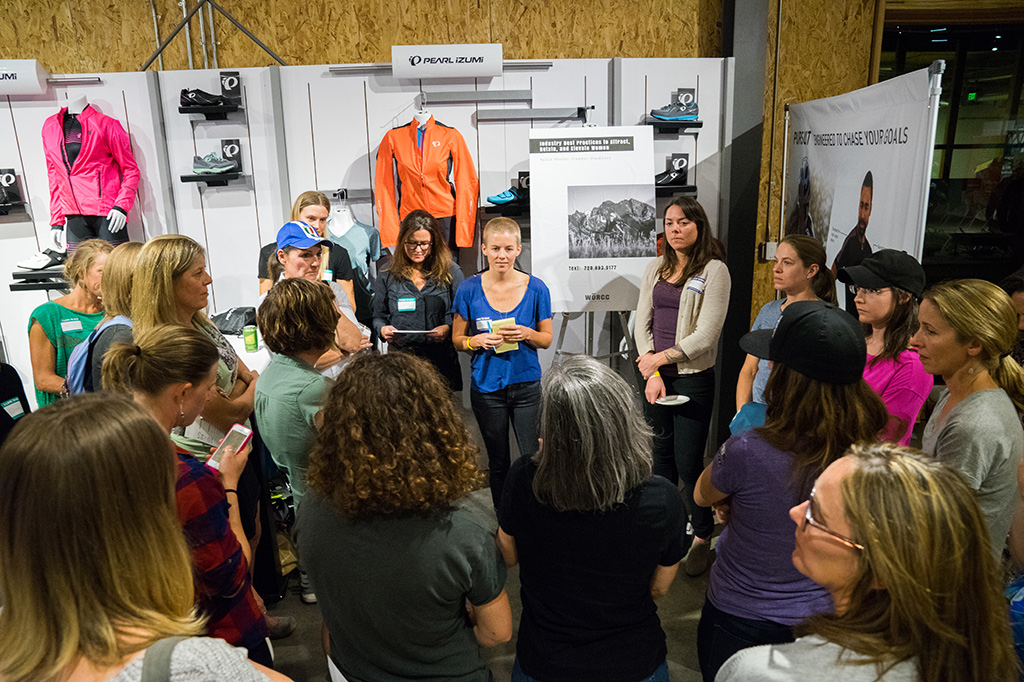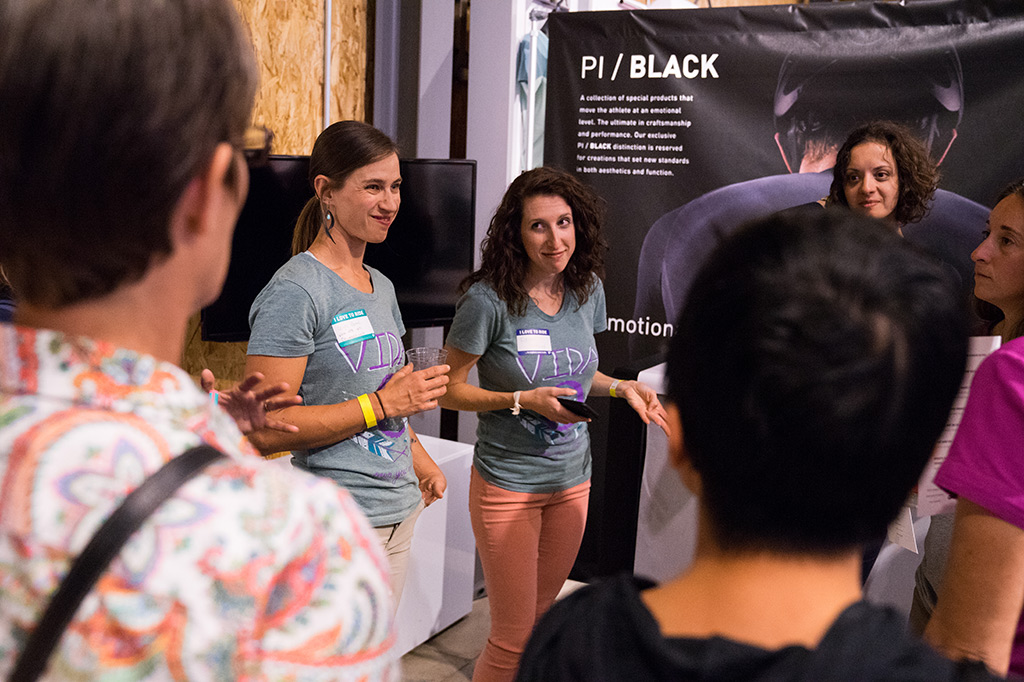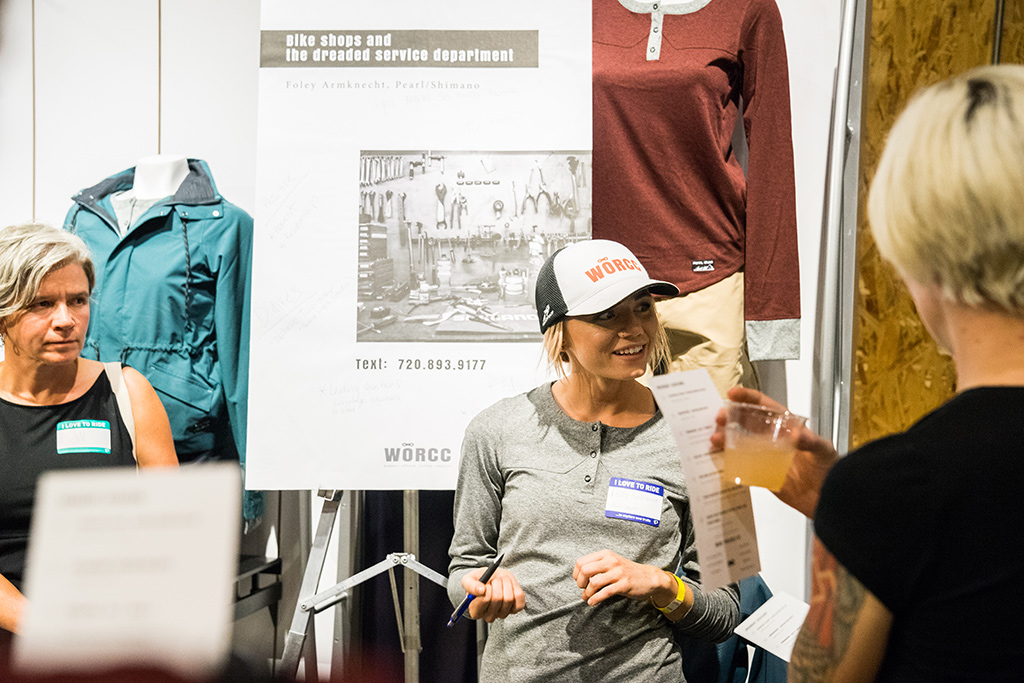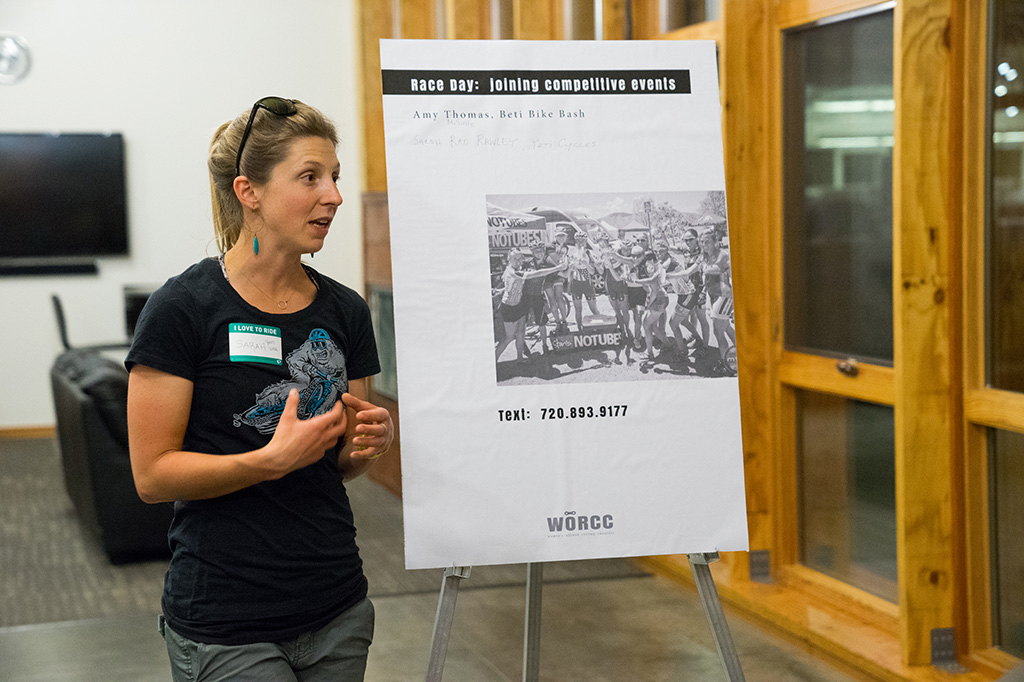And inclusion could mean industry growth, too.
The first-ever Women’s Off-Road Cycling Congress (WORCC) launched in October at the Pearl Izumi World Headquarters in Louisville, Colorado. The goal of WORCC Founder Elori Slater was twofold: to evolve the classic cycling industry ladies’ nights—where retailers invite women to gather over hors d’oeuvres and shop for goods—into an event for intellectual, informative dialogue. The second goal was to record attendee’s feedback regarding their experiences in off-road cycling, in order to provide qualitative data for the bike industry. Anyone can subscribe (sans charge) to the report, which will be released December 2017.
In many ways, the inaugural congress was a success. The event sold out. Slater increased capacity by 15 percent up to 130 attendees. The night beforehand, more folks needed to be turned away due to space and resource limitations. Slater is already in conversation with underwriters to expand the WORCC to at least four U.S. markets in 2018. In Slater’s words, it’s the antithesis of the classic ladies’ nights, and the report will help to improve the health of the bike industry.

Photo: WORCC / Natalie Starr
“As an owner of a mountain bike shop, I did not like how ladies nights’ historically incentivize women to patronize shops: It is very transactional and forgetful, and it does not create the integrity that I want with my women’s audience. I want to build relationships with women in off-road cycling and to have brand equity that’s value driven,” said Slater, co-owner of Sports Garage, a dirt-focused bike shop in Boulder, Colorado. In the state of Colorado, Slater is among roughly four women total who own bike shops, she has been an off-road cyclist for nine years, and she’s a racer. Over time, she’s heard countless women’s testimonials about their day-to-day riding experiences. Simultaneously, she observed the industry’s desire and attempts to improve its connection with women.
When you scroll through advertisements related to outdoor sports—such as rocking climbing and skiing—women are included in those brand photos and stories, said Slater. Mountain biking needs to catch up: The sport’s image is still one that’s painted with male dominance, and the products that are created don’t necessarily reflect women’s direct feedback from their experiences, Slater explained. “As a retailer, I’m in a position to help integrate the conversation of women’s experiences with products and the manufacturers who are creating those products, which could move the needle in the industry,” she said.
The congress could help to fill a never-before-bridged gap between manufacturers, brick-and-mortar stores, and user groups. The format can be replicated across regions and collect qualitative data from various populations. The report may illuminate concepts and needs to inform product design, dealer training for specific user groups, or how media portray riders in mountain biking specific press. However, while the debut WORCC was an event for women, Slater’s mission is not to spotlight gender disparity in the sport.
“We can make the industry better when we start looking at what people’s experiences really are.”
“This is not just about women’s experiences—it’s about anyone that feels intimidated or marginalized by getting into the sport. If I were a 45-year-old dude, 40 pounds overweight, just moved to Colorado, and wanted to get into mountain biking for the first time, I would probably have the same experience as a woman in terms of intimidation and questioning what bike to buy. Am I going to be marginalized? Am I going to be welcomed on the trail? And is there a code of culture that I don’t understand? This isn’t just underscoring the difference between women and men. We can make the industry better when we start looking at what people’s experiences really are,” said Slater. Bicycle Product Suppliers Association (BPSA) Executive Director Ray Keener made a similar point: “It’s not women so much as it is beginners of both genders who can be intimidated and feel unwelcome in specialty retailers of all types, not just bike shops.”
The evening started off with speeches from three industry leaders followed by three 15-minute breakout sessions. Women joined a discussion group of their choice, which were separated by seven general topics such as “Industry Best Practices to Attract, Retain, and Elevate Women,” and “Bikepacking.” Folks texted their ideas and responses via an audience Q&A software or wrote them on sticky notes that were recorded afterward. Prior to the event, a 25-question survey was issued to attendees in order to collect quantitative data about the participants.

Photo: WORCC / Natalie Starr
Jennifer Boldry, Ph.D., Director of Research for People For Bikes, advised Slater on the creation of the survey. “Part of the reason this survey is interesting is that at an industry level, we don’t have a lot of great data,” said Boldry. When she joined People For Bikes, a study had never been completed on the number of people who were riding bikes in the U.S.—so she helped the momentum. In 2014, People for Bikes conducted a benchmark study on bicycling participation across the country that examined different types of bicycling and riders. The study didn’t look specifically at mountain biking, due to its limited bandwidth. However, based off of Boldry’s collective, long-term research—she’s worked as a researcher in the bike industry for eight years—she did notice a big difference between the involvement of men and women in biking in general.
“When you look at all kinds of bicycling, in general, the infrequent people who ride—meaning, one to four times a year—are comprised equally of males and females. As you move up the frequency ladder to people who ride 100-plus days a year, the gender balance shifts radically and gets closer to 70 percent male. And when I look at the small amount of mountain biking data, that pattern is more extreme,” said Boldry. Meaning, a male-heavy gender gap exists at the entry level of mountain biking and that chasm continues to widen among the more experienced categories of riders.
The biggest limiting factor of conducting more research is cost. For a study done on the mountain bike population, an extremely small percentage of the U.S. population would qualify, thus making riders more difficult to find.
In 2015, the Physical Activity Council published a study (not available to the public) on off-road bicycling. The results found that 2.8 percent of the U.S. population, age 6 and up, mountain biked or road on an unpaved surface at least one day in the past 12 months, including participation by 4 percent of males. Comparatively, female participation was 1.6 percent, shared Boldry. “Elori’s vision to build a community is exciting, and in the Denver, Boulder area we have committed off-road riders who are some of the best people for data,” said Boldry.

Photo: WORCC / Natalie Starr
Most attendees of the WORCC were Coloradan with a few out-of-state visitors—including folks from Minnesota and California—and a handful of women who work in non-related fields. The room was full of researchers, product developers, recreationalists and program directors such as University of Colorado Professor of Sociology Jill Harrison, Colorado High School MTB League Director Kate Rau, Camber Outdoors Community Manager Sallie Hoefer and Quality Bicycle Products Manager of Advanced Research & Industrial Design Kate Thompson.
“We wanted to understand what women in this area are experiencing in [off-road] cycling, and help to develop a platform in the industry that can cater to those needs,” said Foley Armnecht, pacific mountain team sales division at Pearl Izumi. When Elori shared the idea for the WORCC with Armnecht less than two months ago, the momentum and need for a new type of women’s event was top of mind. Armnecht saw a need for improvement regarding gender equality in the sport both culturally and economically. “Ellen Noble, a pro cyclocross racer, recently made a point that she received a paycheck that was equal to a man’s for the first time, and it was in the UCI Mountain Bike World Championships field, which is the highest level of racing,” she said. “And in August, the film, ‘Ferda Girls’—a parody of Kendrick Lamar’s song, ‘Humble’—went live, which has been viewed nearly 600K times on YouTube. A lot of women were talking about that video and how it speaks to them,” said Armnecht.
Evidence reflects a growing number of women in off-road cycling. In 2017, the women’s-specific cycling programs offered by REI quadrupled in attendance compared to the year prior, according to REI Director of Outdoor Programs and Experiences Rebecca Bear. The most popular mountain biking course was the Women’s Introduction to Mountain Biking, where riders learn about technique including body and pedal position, shifting, braking, climbing, descending and navigating minor obstacles. The second most popular class is the Mountain Biking Basics class, and participants learn how to take care of their bike. The International Mountain Bicycling Association (IMBA) has experienced a 10-percent increase of women members year over year, according to Brand Developer Director Aimee Ross. The IMBA’s total membership is about 32,000 members, and the annual fee ($39) reflects the rider’s investment in the sport, Ross said. Amy Thomas, co-founder of Team Yeti Best and the Beti Bike Bash women’s only mountain bike race—who helped kick off the WORCC with a presentation—shared that the inaugural race started with 200 pre-registered women eight years ago and grew to more than 400 participants in 2017. The Beti Bike Bash is the largest women’s mountain bike event in the world and caters to all levels including juniors, the ‘Never Ever’ category, seasoned professionals and new moms.

Photo: WORCC / Natalie Starr
“In general, I see more women riding bikes, in part because there is more access for recreationalists today,” said Dorothy Pacheco, who also gave a speech at the WORCC and has been involved in the cycling industry for close to three decades. Pacheco helped to found the former National Off-road Bicycle Association (NORBA) and drafted policies with the UCI to establish mountain biking as an Olympic sport in 1996. She also serves on the USA Cycling Board of Directors as the head of the Mountain Bike Committee and Women’s Committee.
Women also seem to get more involved in the sport’s community than their male counterparts. “When we looked at our most engaged chapters across the U.S., from a leadership standpoint they were heavily skewed toward women who are board members or directors. We found that women leaders are really engaged and are not afraid to take on a challenge and change the landscape,” said Ross. IMBA also recently noticed that 60 percent of their website visitors were looking at the resource page and bouncing off: The majority of those visitors were women age 25 to 34. To parallel those analytics, one of the conversation trends at the WORCC was the question of resources: Why isn’t there one single online resource where women can look up the information they need regarding community rides and races? IMBA has a goal to become that curated source in 2018 with further website development.
Ashley Rankin, founder of women’s mountain bike apparel brand Shredly, was also a keynote speaker at the WORCC event. She spoke of the importance of diversity and experience level within the bike industry. “When I was starting my company … the buyer asked me, ‘What kind of rider are you? What kind of riding do you like to do?’ I didn’t even know how to answer the question. I didn’t know how to categorize myself as a mountain biker—but I knew that I wanted to wear cute mountain bike shorts and wanted other people to wear cute mountain bike shorts, too.” Her key point: “There is an opportunity for this industry to be more inclusive. You are a part of this industry.”


